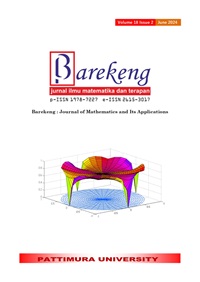PROVING THE CORRECTNESS OF THE EXTENDED SERIAL GRAPH-VALIDATION QUEUE SCHEME IN THE CLIENT-SERVER SYSTEM
Abstract
Numerous studies have been conducted to develop concurrency control schemes that can be applied to client-server systems, such as the Extended Serial Graph-Validation Queue (SG-VQ) scheme. Extended SG-VQ is a control concurrency scheme in client-server system which implements object caching on the client side and locking strategy on the server side. This scheme employs validation algorithms based on queues on the client side and graphs on the server side. This research focuses on the mathematical analysis of the correctness of the Extended SG-VQ scheme using serializability as the criterion that needs to be achieved. Implementing a cycle-free transaction graph is a necessary and sufficient condition to achieve serializability. In this research, the serializability of the Extended SG-VQ scheme has been proven through the exposition of ten definitions, two propositions, three lemmas, and one theorem.
Downloads
References
S. Ali, R. Alauldeen, and R. A. Khamees, “What is client-server system: architecture, issues and challenge of client-server system (review),” Recent Trends in Cloud Computing and Web Engineering, vol. 2, no. I, pp. 1–6, 2020.
J. Gifford, “Remote working: unprecedented increase and a developing research agenda,” Human Resource Development International, vol. 25, no. 2, pp. 105–113, March 2022.
Q.-V. Dang and C.-L. Ignat, “Performance of real-time collaborative editors at large scale: user persperctive,” in 2016 IFIP Networking Conference and Workshops, pp. 548–553, May 17-19, 2016.
M. Härtwig and S. Götz, “Mobile Modeling with Real-Time Collaboration Support,” Journal of Object Technology, vol. 21, no. 3, pp. 1-5, July 2022.
T. Connolly and C. Begg, Database Systems: A Practical Approach in Design, Implementation, and Management Database, 6th ed. Essex: Pearson Education, 2015, 99-100.
M. Kaur and H. Kaur, “Concurrency control in distributed database system,” International Journal of Advanced Research in Computer Science and Software Engineering, vol. 3, no. 7, pp. 1443–1447, July 2013.
F. Bukhari and S. Shrivastava, “An Efficient Distributed Concurrency Control Scheme for Transactional Systems with Client-Side Caching,” in Proceedings of the 14th IEEE International Conference on High Performance Computing and Communications, HPCC-2012 - 9th IEEE International Conference on Embedded Software and Systems, ICESS-2012, pp. 1074–1081, Jun. 25-27, 2012.
M. F. Jauhari, “Skema serial graph-validation queue (sg-vq) pada sistem klien-server,” Master thesis, IPB Univ., Bogor, Indonesia, 2024.
T. Wang, R. Johnson, A. Fekete, and I. Pandis, “Efficiently making (almost) any concurrency control mechanism serializable,” International Journal on Very Large Data Bases, vol. 26, no. 4, pp. 537–562, August 2017.
F. Bukhari, Maintaining Consistency in Client-Server Database Systems with Client-Side Caching. Doctoral [Dissertation]. Newcastle upon Tyne: Newcastle Univ., 2012. [Online]. Available: Newcastle University Theses.
A. Mhatre and R. Shedge, “Comparative study of concurrency control techniques in distributed databases,” in Proceedings - 2014 4th International Conference on Communication Systems and Network Technologies, CSNT 2014, pp. 378–382, Apr. 7-9, 2014.
Fathansyah, Basis Data, 3rd ed. Bandung: Informatika Bandung, 2018, 312-318.
A. Silberschatz, H. F. Korth, and S. Sudarshan, Database System Concepts, 6th ed. McGraw-Hill, 2011, 661-667.
T. V. A. Parreira, Empowering a Relational Database with Lsd: Lazy State Determination. Master [Thesis]. Lisbon: NOVA School of Science and Technology, 2022. [Online]. Available: Repository of NOVA University (RUN).
P. A. Bernstein, V. Hadzilacos, and N. Goodman, Concurrency Control and Recovery in Database System, no. 2. Addison-Wesley, 1987, 1-34.
Y. Heryadi and I. Sonata, Dasar-Dasar Graph Machine Learning dan Implementasinya Menggunakan Bahasa Python. Yogyakarta: GAVA MEDIA, 2022, 1-4.
P. A. Bernstein and N. Goodman, “Concurrency control in distributed database systems,” ACM Computing Survey, vol. 13, no. 2, pp. 185–221, June 1981.
Copyright (c) 2024 Fitra Nuvus Salsabila, Fahren Bukhari, Sri Nurdiati

This work is licensed under a Creative Commons Attribution-ShareAlike 4.0 International License.
Authors who publish with this Journal agree to the following terms:
- Author retain copyright and grant the journal right of first publication with the work simultaneously licensed under a creative commons attribution license that allow others to share the work within an acknowledgement of the work’s authorship and initial publication of this journal.
- Authors are able to enter into separate, additional contractual arrangement for the non-exclusive distribution of the journal’s published version of the work (e.g. acknowledgement of its initial publication in this journal).
- Authors are permitted and encouraged to post their work online (e.g. in institutional repositories or on their websites) prior to and during the submission process, as it can lead to productive exchanges, as well as earlier and greater citation of published works.






1.gif)



